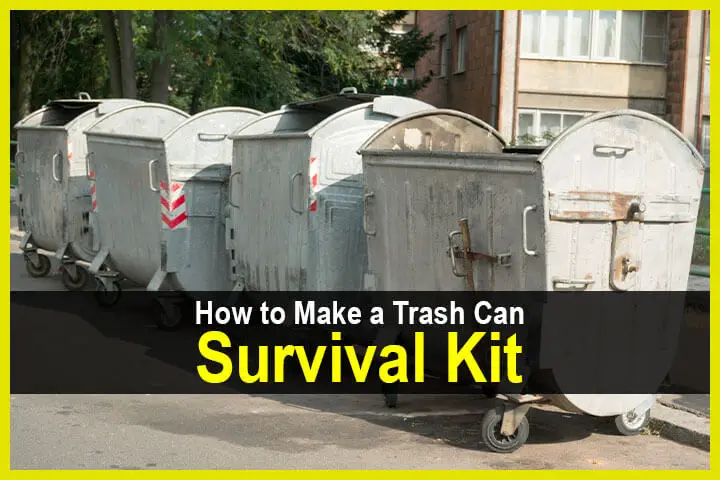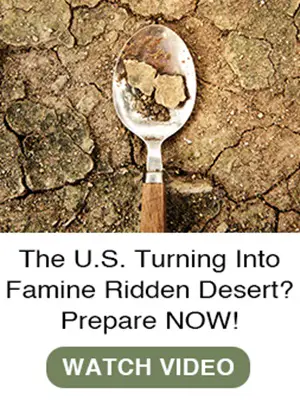Estimated reading time: 11 minutes
In the realm of survival, one often overlooked tool is the humble trash can. Its utility in emergencies is unparalleled in terms of storage and stealth. This article introduces the concept of a ‘Trash Can Survival Kit’, a novel approach to emergency preparedness that hinges on the usage of everyday household items.
Since you probably already know the importance of being ready for any contingency, we will guide you to equip yourself with essential survival tools that can fit snugly in your trash can. Expect to learn about versatile items to include in your kit, innovative usage ideas, and how this kit can become a lifesaver in unexpected situations.
Want to save this post for later? Click Here to Pin It On Pinterest!
Understanding the Concept of a Trash Can Survival Kit

The trash can survival kit is a fresh take on emergency preparedness, with the idea originating from the recognition of reusing and repurposing everyday items. The concept is straightforward – turning an ordinary household object, a trash can, into a repository for survival essentials.
However, there is a question that arises – why a trash can? The answer to that can be found in its versatility and ubiquity. A trash can is durable, waterproof, and large enough to store a variety of survival items, ranging from food and water to tools and medical supplies.
Additionally, in an emergency scenario, the trash can itself can serve multiple purposes – an improvised shelter, water collector, or even a flotation device in a flood situation.
Pros and Cons of a Trash Can Survival Kit

Now that we’ve given you an understanding of what a trash can survival kit is and why it can be beneficial during an emergency, let’s look at why you may or may not want to use one for an emergency for you and your family.
Pros of a Trash Can Survival Kit

One of the key advantages of a trash can survival kit is its spaciousness. Unlike traditional emergency kits, a trash can survival kit provides ample storage space, accommodating a vast array of survival essentials without the need for additional containment solutions. This allows for a comprehensive, all-encompassing survival kit for diverse crises.
The inherent durability of trash cans, typically constructed from robust plastic or metal, also ensures the survival kit is watertight and resistant to external elements. This means that the contents of your kit remain secure and accessible regardless of weather conditions or extended periods of storage.
The unassuming nature of trash cans provides a hidden advantage. As an ordinary household item, a trash can doesn’t attract attention or incite curiosity, making it an unlikely target for theft or tampering. It can be subtly tucked away on your property or concealed in your surroundings, ensuring your survival kit remains intact until needed.
Cons of a Trash Can Survival Kit

The size of a trash can, while advantageous for storage capacity, poses significant drawbacks when it comes to portability. Their voluminous nature, often filled to the brim with essentials, can become a hindrance when quick evacuation is required in an emergency. It can be remarkably cumbersome to haul, especially over extended distances, turning a survival tool into dead weight.
And while it may hold a lot, the simple bin-style design of a trash can presents challenges in terms of organizing your survival gear. In times of crisis, when seconds count, the lack of compartments or a systematic arrangement can
translate into valuable time wasted rummaging for needed items.
If you want to keep anything with an expiration date, the lack of an airtight seal in trash cans is a considerable disadvantage. While they can keep the water out, they fail to provide a hermetic environment, allowing air to get in. This could compromise the longevity of perishable items, such as food or medical supplies, potentially leading to spoilage or ineffectiveness when you need them the most.
How to Camouflage or Hide Your Trash Can Survival Kit

Securing your trash can survival kit involves striking a balance between concealment and accessibility. Here are a few strategies to achieve this delicate equilibrium.
Choosing the Right Location
The first step to hiding your survival kit effectively is selecting a suitable location. This should ideally be an area that is inconspicuous yet reachable. Consider places that are a part of your everyday environment, like your garage or utility room. These areas offer the advantage of being within quick access, while also being part of your property’s natural layout, thereby reducing suspicion.
For those residing in rural areas with expansive properties, further diversification in your survival kit placement can be advantageous. Strategically positioning multiple “satellite” survival kits across your property not only ensures consistent resupply but also provides a directional advantage during emergencies.
This approach takes advantage of the sprawling nature of rural properties, allowing you to retreat and move towards these cache points, maintaining a steady supply of resources while staying mobile. By dispersing your survival kits, you reduce the risk of losing all your supplies in one unfortunate event and increase your chances of survival.
Camouflaging in Plain Sight
Your survival kit doesn’t have to be buried in a hole or locked in a safe to remain hidden. Sometimes the best place to hide something is in plain sight. Use a bit of creativity to blend your trash can with its surroundings. Paint it with colors or patterns that match your property or use decals of prevalent household items. The goal is to make it appear as ordinary as possible, thereby diverting attention away from it.
Layering Items
If your survival kit were to get pillaged, try hiding the contents. Consider implementing a layering strategy inside the trash can. Store non-essential items at the top, acting as a disguise for the critical survival gear beneath. This way, even if someone does open the can, they won’t immediately spot the survival kit.
Essential Items to Include in Your Trash Can Survival Kit
Survival in an emergency depends on preparedness, and a well-stocked survival kit is key. Here are the essential items you should consider including in your trash can survival kit.
Food and Water

- Non-perishable food items: Include a variety of canned goods, dried fruit, nuts, and protein bars. These provide essential nutrients and have a long shelf life.
- Water purification tablets: These are critical for purifying unsafe water in situations where boiling is not an option.
Shelter and Warmth

- Emergency blankets: Also known as space blankets, they reflect body heat to the user, helping to prevent hypothermia. They are often made of Mylar and can be found relatively pretty easily in any hardware or discount stores.
- Small tent: Compact and lightweight tents offer shelter from the elements. They don’t require any special skills to set up.
- Hand warmers: These chemical hand warmers provide heat in cold conditions and can be life-saving in winter emergencies.
- Tarps: These are compact and lightweight items that can be turned into a variety of shelters very quickly.
First Aid Supplies

- Bandages: Include different sizes for various types of injuries.
- Antiseptics: These are essential for cleaning wounds and preventing infection. You can find them in easy-to-apply gels or a soaked pad.
- Painkillers: Over-the-counter pain relievers can alleviate discomfort from injuries. This can include ibuprofen, acetaminophen, and others.
- Medication: If you have a chronic condition, it’s important to include an extra supply of your medication.
Tools

- Multi-tool: A multi-tool with a knife, can opener, and screwdriver can be incredibly useful in a variety of situations.
- Flashlight: This is essential for navigating in the dark. Include extra batteries for longevity. Hand crank flashlights don’t need to have an external power source. Solar power flashlights are effective and only need the sun to charge, the downside is that they take a very long time to charge.
- Batteries: Don’t forget to pack extra batteries for any battery-operated tools or devices. Rechargeable batteries are excellent if you have a way to charge them.
Communication Devices

- Crank radio: A crank radio can provide important news updates and information during disasters. most come equipped with additional features such as a compass or a flashlight built in.
- Whistle: This simple device can be used to signal for help. Don’t cheap out, look for a robust whistle made of high-grade plastic or even stainless steel.
- Satellite Phone: In areas where cell service is unreliable or non-existent, a satellite phone can be a lifesaver. It uses satellite signals to communicate, making it practical in virtually any location. Be mindful though, that in an emergency, even satellite service may go down.
Navigation Aids

- Compass: A compass can help with direction-finding if you’re lost or disoriented. A compass with built-in declination is superior because it adjusts for the difference between magnetic north and true north. This feature increases navigation accuracy, ensuring you stay on course, especially crucial in complex terrains or long-distance travels.
- Maps: Include local maps with marked evacuation routes. A topographic map is essential for outdoor adventures as it details the terrain’s elevations, contours, and features. This map type provides crucial information about inclines, declines, water bodies, and landmarks, aiding accurate navigation and planning of routes. It’s the ideal companion to a compass.
Additional Tips for Your Trash Can Survival Kit

Regularly checking and updating your survival kit is critical to ensure its effectiveness in emergencies. Over time, some items may deteriorate or become obsolete, thus requiring replacement. For instance, non-perishable food and water should be switched out every six months to a year, while batteries and first aid supplies should be checked for their expiration dates.
Customizing your survival kit based on personal needs and regional disasters could substantially bolster your readiness. For example, if anyone in your family requires prescribed medication, ensure to include it. If you live in a region prone to specific disasters like earthquakes or hurricanes, pack specialized gear such as a dust mask or hurricane (kerosene) lantern. Tailoring the kit to your unique requirements and potential threats in your locale heightens your preparedness.
Conclusion
Investing in a trash can survival kit is a practical and lifesaving measure, as it ensures readiness for unexpected emergencies, providing essential supplies that can sustain you and your family until help arrives. The beauty of this kind of kit is that it can be as large or as small as you want, as long as it is functional and can help you when you need it.
Like this post? Don’t Forget to Pin It on Pinterest!


















